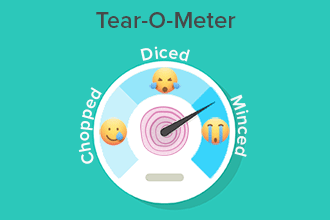All about onions, your eyes and how to turn off the tears

Why do onions make you cry?
You’re in the kitchen making gazpacho, whipping up some French onion soup or prepping a smorgasbord of burger toppings. You grab an onion, slice in and, within seconds, your eyes begin to burn and tears spill down your cheeks.
Onions contain a chemical compound and an enzyme that mix to release an irritating gas when the onion is cut. This helps keep the bulb from getting eaten by animals as it grows in the ground, says Eric Block, a distinguished professor emeritus at the University at Albany, food chemistry expert and author of Garlic and Other Alliums: The Lore and the Science.
“This is a way for the onion to defend itself against predators,” he says.
Why do onions make your eyes burn?
Onions make your eyes burn for the same reason they make you cry: thanks to the combination of that chemical compound and the enzyme that synthesize when an onion is cut. This creates syn-propanethial-S-oxide, a volatile gas that makes your eyes burn and fill with tears.
Here’s how the process works:
The onion contains both the chemical precursor to the gas and an activating enzyme that floats in onion cells in little walled-off areas (vacuoles).
An onion gets sliced, diced or bitten into.
The precursor and enzyme mix, creating an unstable chemical irritant.
At room temperature, this irritant quickly becomes a gas that spreads through the air.
The gas triggers pain receptors in the eyes and nose designed to protect you from chemicals, smoke and other dangers.
The tear glands (lacrimal glands) in the eyes then make tears to wash away the irritant.
“It’s a very small molecule,” Block says of the noxious syn-propanethial-S-oxide. “But it packs a surprising punch for its size.”
How do tears protect your eyes from irritants?
Tears help to lubricate your eyes and protect them from dust and other irritants, says Dr. Darryl Glover, an optometrist, author and speaker.
The eyes make two main types of tears:
Basal tears – These tears lubricate the eyes and keep them healthy.
Reflexive tears – These tears irrigate the eyes and flush away irritants.
A healthy tear film — plenty of basal tears — helps prevent your eyes from becoming irritated in the first place, while reflexive tears help to wash away irritants and protect the eyes, Dr. Glover says.
If you cut an onion and start to cry, wash your hands thoroughly and blot your eyes with a clean paper towel, Dr. Glover recommends. Don’t use tissues, which may contain lotion and shed lint that can make the problem worse. Finally, put a few drops of preservative-free artificial tears in your eyes.
“That may give you a little bit of relief,” he says.
Are people who wear contacts more (or less) affected?
Some contact lens wearers swear their lenses provide a shield against eye-irritating onion fumes. I wear contact lenses and also own a spare pair of glasses, so I decided to put this question to the test.
Before starting my experiment, I asked Dr. Glover if he thought contacts could either protect my eyes during onion cutting or worsen the irritation.
“I could see it going either way,” he says.
As Dr. Glover explains it: On one hand, a contact lens covers the cornea, which contains nerves and pain receptors that react to the gas released when cutting onions. On the other hand, contact lenses can disrupt the tear film and may lead to dry eyes, which affects basal tear production. Having dry eyes can make the irritation of cutting onions even worse.
An experiment: Cutting onions with contacts vs. no contact lenses
With Dr. Glover’s insight in mind, I tried cutting various types of onions with my contacts in, then again while wearing my glasses.
Wearing contact lenses
I found that cutting onions of any kind with my contacts in only mildly irritated my eyes, even when I intentionally tried to breathe in the fumes.
Wearing glasses
Cutting the same types of onions without my contacts in made me weep.
Mincing a yellow onion without my contacts in was the worst: It led to a flood of tears and so much irritation that my right eye actually started to twitch.
“Do you see that?” I shouted to my husband, who was slicing a nice, mild green pepper, as tears gushed down my cheeks. “My eye is actually twitching!”
SEE RELATED: Infographic: How to make that eye twitch go away
Which onions make you cry?
I bought an array of onions to test in my kitchen: yellow onions, white onions, red onions, sweet onions and green onions.
My reactions ranged from sobbing, sniffling, coughing (and cursing the onion) to slightly watery eyes with mild nose and throat irritation to almost no reaction. But each type of onion, except the green onions, made me at least a little teary eyed.
So, which onions made me cry the most? Here’s what I found, ranking the types of onion in order of most to least likely to bring on a crying jag:
Yellow onions
Red onions
White onions
Sweet onions
Surprisingly, even sweet onions — which can be eaten in thick slices on burgers, or minced into a summer salad — can still make you cry.
So which onions don’t make you cry? There’s only one kind guaranteed not to bring on the waterworks: tearless onions.
These onions, marketed as Sunions, are grown in Nevada and Washington and sold only at certain times of year. They’re the product of a cross-breeding program to select for sweetness and tearlessness.
“Apparently the taste is pretty decent,” says Block, who spotted Sunions for sale in a grocery store in Colorado. “But I haven’t tasted them.”
How to cut onions without crying
There is good news for home cooks: Chopping this “savory allium” does not need to turn you into a blubbering mess. As long as onions have been bringing tears to eyes, the hunt has been on for how to cut them up without all the crying.
Some advice on how to cut onions without crying sounds silly — for example, chewing gum, holding a baguette in your mouth or lighting a match, blowing it out and letting the smoke waft around you while you chop.
And earlier this year, onion lovers everywhere got excited when a video describing an onion-chopping hack went viral on TikTok. Sadly, it turns out leaving a damp (or wet) paper towel on your cutting board doesn’t work for everyone.
“That’s a lot of nonsense,” Block says of some of the more farfetched tricks.
At first I thought avoiding cutting into the root end of the onion also sounded like a kitchen myth, but the National Onion Association actually recommends this trick. This is because the root contains a higher concentration of the compound that forms the gas that makes you cry.
Another experiment: Testing tricks for tearless onion-cutting
I tested five seemingly reasonable tips for cutting onions without crying to see which worked best.
I tried:
Cutting the onion in the sink under running water
Donning onion goggles (see our pick for best onion goggles)
Popping an onion into the freezer for 30 minutes before cutting it
Turning on the vent hood fan while chopping onions on the stovetop
Slicing an onion without cutting into the root
Slicing and dicing an onion in the sink under running water worked, but it was awkward — I nicked my thumb with the knife — and it made the onion soggy. The freezer trick cut down on fumes by about 70%, but my eyes still watered.
Plus, getting the onion wet, or chilling it, could affect the way the onion performs and tastes in the dish, notes Block.
So what does work? In my experience, here’s how to cut onions without crying:
Start by cutting off the top of the onion, then peel the skin off the bulb, leaving it attached to the onion at the root to help you avoid slicing into the root end. Start slicing at the top, working your way toward the root and stopping about a quarter inch away.
Cut the onion on your stovetop under a vent hood with the fan turned on high.
“That’s [under a vented stovetop] by far the most reasonable and practical thing to do without altering the flavor of the onion,” Block says.
How do chefs chop onions without crying?

Fun eye fact: The smaller you cut (or crush or pulverize) onions, the more they make you cry. That’s because the action of cutting causes the chemical reaction that leads to tears.
How do the pros mince, dice, chop and slice onions without shedding a tear? Tears in the kitchen aren’t a problem for chefs, says Jason Hawk, a chef-instructor with the Institute of Culinary Education (ICE).
“The main thing is, first, having a sharp knife and, second, having a proper cutting technique,” he says.
Instead of using a lot of force and pressing straight down, which can bruise the onion, break down the cell walls and release the onion juices, you want to start closer to the tip of the knife and "rock down and roll through" the onion, Hawk says.
Want to see a chef cut an onion? Here’s a basic knife skills video from ICE.
And once again: “Keep your knives nice and sharp,” emphasizes Hawk.
Onion goggles may help cut down on tears
If you cook with onions a lot, make room for a new kitchen gadget.
It’s time to try some onion goggles.
It may be an especially good idea for cooks who suffer from dry eye to use onion goggles or a similar type of protective eyewear, Dr. Glover says.
However, goggles aren’t always a perfect solution. Block points out that noxious onion vapors affect more than just your eyes. The fumes can also enter the nose, target pain receptors there and activate tears that way.
“If the eyes are completely sealed it might help,” he says. "But as long as you’re breathing, you’re still going to inhale the fumes."
He jokingly tosses out a solution that would look far weirder than wearing onion goggles: “You could cook with a scuba mask and an oxygen tank on your back,” he says. “Then there’d be no effect at all.”
READ NEXT: Why Crying Is Good for Your Health
Why does chopping an onion make you cry? Library of Congress. November 2019.
You don’t have to cry: 5 ways to stop onion-cutting misery. Foodal. February 2016.
We tried the viral onion-cutting hack to save you some tears. Refinery29. April 2021.
Frequently asked questions. National Onions Association. Accessed September 2021.
Sunions home page. Sunions. Accessed September 2021.
How to cut an onion (how to dice, mince, and chop onions). The Cookie Rookie. November 2019.
Page published on Wednesday, September 15, 2021




